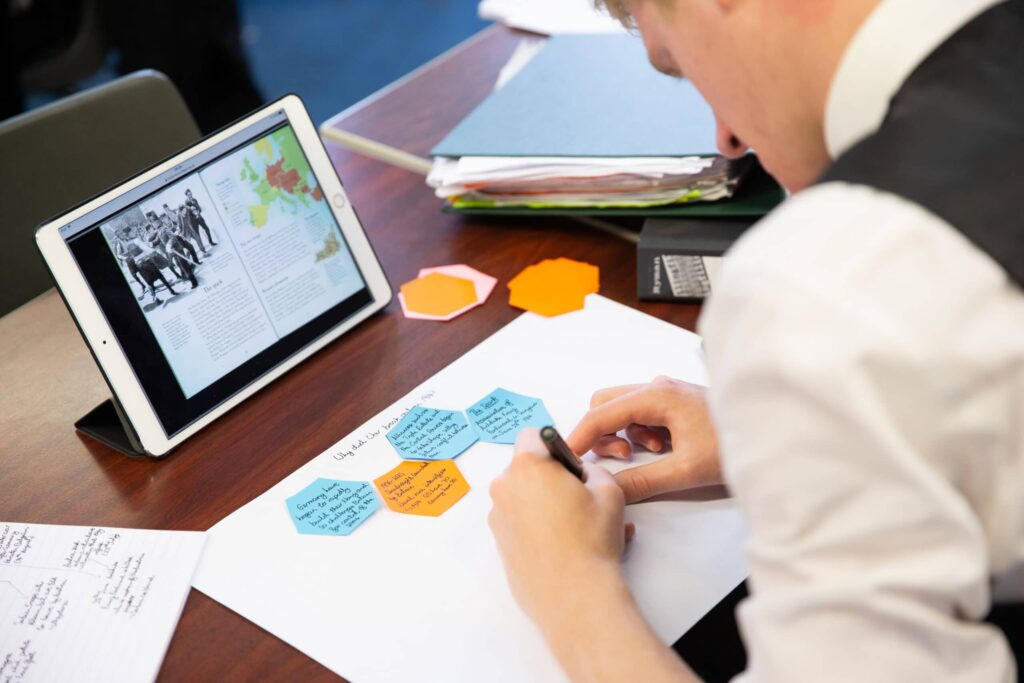This week’s blog post is based on the body language workshop delivered to masters by Mike Carter during the Summer Half inset day. The post considers some of the techniques discussed by Mike and draws upon evidence-based research from the field.
Mike began his session by stating that teachers are ultimately professional communicators. Indeed, research shows that the way in which teachers communicate with students can positively affect their perceptions of school; their role in the classroom; themselves and their abilities; and their motivation to succeed.[1] However, Mike argues, that our most effective communication occurs when teachers acknowledge the role of body language. When used alongside verbal cues, it has the ability to enhance our message, confuse the message or even shut down our audience completely. Therefore, it is vital that we recognise its importance in the classroom.
Hands and feet
The position or movement of our hands and feet can often reveal the most about how we are feeling. When gesturing with our hands, it is important to remember that ‘palms up’ usually implies warmth and an invitation to engage, whereas ‘hands down’ suggests gravitas or a serious tone.[2] When trying to instil effective behaviour management in the classroom, using the latter will inevitably be more effective. Further to this, Mike also suggested that it is important to keep your hands in view. When we hide our hands, we tend to lose our credibility. If you’re tucking your hands into your sleeve, putting them in your pockets, sitting on them or folding your arms, students can tell that their teacher is uncomfortable.[3] Therefore, it is important to keep your hands open and in sight at all times, with elbows at right angles to keep your hands in the optimal position.
Feet are just as important, and in particular the direction in which they are pointing. The direction of feet can often indicate the direction the individual would like to go i.e. if you are pointing your feet towards the person you are speaking to, it indicates that you’re interested in what they have to say. If you’re pointing them in the direction of the door, it implies that you would like to leave. This also links to your position in the classroom, as memory is linked to geography and students remember things better in specific places.[4] Griffiths (2005) argues that if you give certain messages from certain spaces, you need to keep this consistent in order for students to remember things better.[5]

Self-soothing behaviour
Another important aspect of body language to pay attention to is self-soothing behaviour. If a student is feeling uncomfortable or ill at ease they may attempt to calm themselves and touch is often used in this way. Actions such as crossing one’s arms do not necessarily mean the student is trying to establish a barrier; instead, it could be them replicating the feel of a hug. Touch can also include touching one’s face or other parts of the body for comfort.[6] At the extreme end, this can sometimes escalate into self-harm which provokes a more intense response. However, more often than not, it manifests in touching one’s arms or face or neck.
Active listening
In order to communicate effectively one has to also exhibit active listening. Often people believe that both the speaker and the listener should maintain eye contact during conversations; however, Mike Carter argues that the speaker can break eye contact at any time. It is the listener who must maintain it. When a listener breaks eye contact, it tends to mean something. Eyes up usually implies boredom whereas, eyes down tends to mean shame or embarrassment. The important thing to remember with eye contact, though, is that it is a cultural thing and can mean different things in different areas of the world. In some cultures, for example, when the listener breaks eye contact it can denote respect.
Another way to demonstrate active listening in the classroom is to engage in gentle head nodding when a student is talking to you. This action suggests ‘yes, I agree with you’, or ‘yes, we’re on the same wavelength’. If you’re struggling to participate in a group discussion, one technique is to head nod towards the main speaker and they will begin to direct their attention to you which then makes it easier to contribute.
Voice control and breathing
Sighing is often linked to boredom. This is because you can’t sigh unless you hold your breath first, and we tend to hold our breath when we’re uncomfortable of feeling emotionally on edge. However, when we breathe deeply, it makes the people around us feel more comfortable and this can be achieved by voice control. Therefore, try not to run out of breath when you talk. When thinking about intonation, it is important to pay attention to consonants and vowels. Consonants are about meaning and vowels are about emotion. If you want to hammer home meaning, emphasise your consonants and ensure that they are clear; whereas if you want to convey a specific emotion then emphasise the vowels.
Despite this advice, Mike ended the session by reminding us not to obsess over body language. Body language can be an effective tool to use in all aspects of life, but if you become hyper aware of it, you’ll come across unnatural. He advised that one should focus on just one thing at a time, and that way the other aspects will come naturally.
[1] Dobbs-Oates, Jennifer & Arnold, David, (2009), ‘The Relationship Between Preschool Teachers’ Reports of Children’s Behaviour and Their Behaviour Toward Those Children’, School Psychology Quarterly: The American Psychological Association, Vol. 24, pp. 95-105.
[2] Restuningrum, Novi. (2018), ‘Teachers’ Strategy of Positioning in Teaching Young Leaners’, Available: https://www.researchgate.net/publication/328192265_TEACHERS’_STRATEGY_OF_POSITIONING_IN_TEACHING_YOUNG_LEARNERS_Novi_Rahayu_Restuningrum Accessed: May 2022.
[3] Bertrand, J., (2009), Managing Young Learners, Teaching English Online, Available: https://www.teachingenglish.org.uk/article/managing-very-young-learners Accessed: May 2022.
[4] Larsen, M., (2015), ‘Your Position in the Classroom’, People, Places, Things Online, Available: http://www.pptpdx.com/china-chuangkou/classroom-management-iii-your-position-inthe-classroom/ Accessed: May 2022.
[5] Griffiths, B., (2005), Teacher Positioning in the Classroom, Teaching English Online, Available: https://www.teachingenglish.org.uk/article/teacherpositioning-classroom, Accessed: May 2022.
[6] Minahan, Jessica, ‘Teaching Self-Calming Skills’, Responsive Classroom Online Blog, (2013), Available: https://www.responsiveclassroom.org/teaching-self-calming-skills/ Accessed: 10 May 2022.




